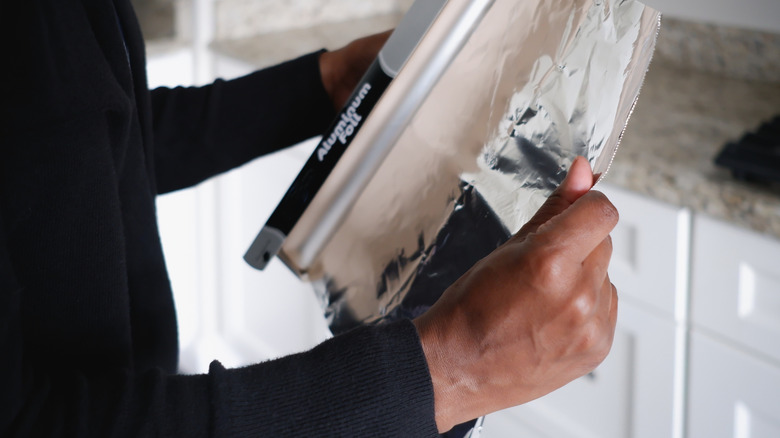The Aluminum Foil Hack That Will Keep Your Hummingbird Feeder Cool In The Heat
If you've ever been too eager to enjoy a hot bowl of soup, you've likely experienced the scorching burn when the liquid hits your tongue. Thankfully, safely eating the rest of the soup means cooling it off with our breath and having a little patience. Hummingbirds, however, don't have that luxury. If their feeder is hanging in direct sunlight on a hot summer day, the nectar can burn the birds' tongues.
More importantly, liquid that is hotter than 102.2 degrees Fahrenheit can harm a hummingbird's vital metabolic system and disrupt its body's ability to constantly refuel and power their energy. Warm temperatures also can speed up the fermenting process of the sugar water. Generally, fermentation isn't always harmful, but in this case it is. Birds can develop an enlarged liver from drinking fermented nectar.
One hack that may keep the nectar cool is to wrap aluminum foil around the reservoir of your hummingbird feeder, keeping any access points for hummingbirds accessible. Foil is used in instances where heat needs to be reflected, but not radiated back outward. Foil wrapped around a feeder reflects the sun's ultraviolet rays, protecting the nectar within and keeping it cool. Just as people are encouraged to set up foil-covered cardboard or similar reflectors in their windows during cases of extreme heat, foil on a feeder works the same way.
Keeping a hummingbird feeder cool and clean
Since the temperature of the nectar can fluctuate depending on external factors, the best way to ensure safe feeding conditions is to incorporate extra precautions in addition to using the foil hack. Aim to keep the hummingbird feeder in the shade — or at least in a spot with afternoon shade when the sun can be most intense. This keeps the nectar cooler and helps prevent leakage. When placed in the sun, hot air within a bottle feeder can expand, forcing nectar to leak out. If you're making your own hummingbird feeder, using a glass bottle keeps the nectar at a lower, safer temperature than a plastic option. For a nectar-free option, use overripe bananas to attract hummingbirds instead.
During most seasons, cleaning the feeder about every three days — or even less during cooler temperatures — is sufficient. But during hot weather, the feeder will need to be refilled even more frequently (every other day is ideal). Vigilantly monitor and clean the feeder to avoid fostering any conditions that could make a hummingbird sick. Mold or cloudy nectar are telltale signs that the feeder needs to be cleaned ASAP.
If the reservoir isn't dishwasher-safe, wash it with hot water and hydrogen peroxide. Vinegar is another effective disinfectant; be sure to rinse the feeder until you can no longer smell the vinegar. Once a month, do a thorough cleaning with a solution that is 1 tablespoon of bleach in a quart of water. This is also an effective way to clean mold out of a glass hummingbird feeder. Rinse with water until you can't smell the bleach anymore.

